Utah has a very unique and diverse history. From Native Americans to trappers, traders, explorers, Mormon pioneers to cowboys. The big mining boom, to the railroad and then finally State Hood. Along the way pieces of history were left behind waiting to be explored. Dwellings of Utah's Native Americans, to ghost towns of the old mining boom, to houses built by the Mormon pioneers. These sites have been set aside for our generation to learn more about Utah's past. Below you find a list of sites that we have visited with information about each.
Previous Page - Next Page
The Brigham City Train Depot
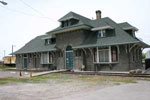 The Oregon Short Line Company was established in 1878 to provide the Union Pacific Railroad access to the Pacific Northwest. The company announced in 1906 that it would construct a modern new depot in Brigham City. The depot was completed and opened to the public on May 19, 1907. Over the years, this depot served thousands of train passengers.
The Oregon Short Line Company was established in 1878 to provide the Union Pacific Railroad access to the Pacific Northwest. The company announced in 1906 that it would construct a modern new depot in Brigham City. The depot was completed and opened to the public on May 19, 1907. Over the years, this depot served thousands of train passengers.
The Brigham City Tabernacle
 Built in 1854, the Beehive House was home to the president of the LDS Church and the governor of the Utah Territory, Brigham Young. The name (The Beehive House) is drawn from the Beehive that sits atop this historic mansion. A Beehive, which is the symbol of industry reflects Brigham Young's belief in a strong work ethic. The Beehive is still the prominent symbol throughout Utah today.
Built in 1854, the Beehive House was home to the president of the LDS Church and the governor of the Utah Territory, Brigham Young. The name (The Beehive House) is drawn from the Beehive that sits atop this historic mansion. A Beehive, which is the symbol of industry reflects Brigham Young's belief in a strong work ethic. The Beehive is still the prominent symbol throughout Utah today.
Sunshine Canyon, Utah West Desert
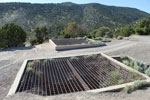 In this outdoor activity we decided to take a quick trip to explore Sunshine Canyon, which is located in Utah’s west desert roughly 3 miles south of Mercur Canyon. The canyon road is well marked from highway 73 and requires driving up a rough, rocky dirt road approximately 2.4 miles to the Sunshine mining site. The road is part of the Sunshine Canyon OHV loop and it is a popular location for ATV and UTV enthusiasts. Sunshine was once a mining town that was home to several structures that were commonly found in Utah’s mining towns. These included saloons, boarding houses, gambling dens, and old miners’ cabins. There were several mines in the area, including the Sunshine in which the town is named after.
In this outdoor activity we decided to take a quick trip to explore Sunshine Canyon, which is located in Utah’s west desert roughly 3 miles south of Mercur Canyon. The canyon road is well marked from highway 73 and requires driving up a rough, rocky dirt road approximately 2.4 miles to the Sunshine mining site. The road is part of the Sunshine Canyon OHV loop and it is a popular location for ATV and UTV enthusiasts. Sunshine was once a mining town that was home to several structures that were commonly found in Utah’s mining towns. These included saloons, boarding houses, gambling dens, and old miners’ cabins. There were several mines in the area, including the Sunshine in which the town is named after.
Harper Ghost Town
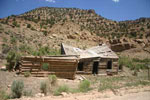 Located approx 30.9 miles into the canyon just off the road are several run down log cabins, the only remains left from this old stage coach stop. The town of Harper once consisted of a saloon, hotel, store, post office and school. A telegraph line connected Harper to Fort Duchesne. Today Harper is posted, so please respect this private property.
Located approx 30.9 miles into the canyon just off the road are several run down log cabins, the only remains left from this old stage coach stop. The town of Harper once consisted of a saloon, hotel, store, post office and school. A telegraph line connected Harper to Fort Duchesne. Today Harper is posted, so please respect this private property.
Gold Hill
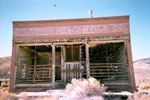 Located deep in Utah’s west desert near the Nevada border is the famous mining camp of Gold Hill. The town established in 1892 was named after a gold bearing mountain just east of the town. Gold Hill became famous for its location of many minerals including silver, gold, copper, lead, tungsten, and arsenic. The town boomed and died several times in its existence. The first boom lasted for a decade until its richest mines were worked out and the town was nearly abandoned. During World War I arsenic was badly needed and Gold Hill was just the location to find the mineral.
Located deep in Utah’s west desert near the Nevada border is the famous mining camp of Gold Hill. The town established in 1892 was named after a gold bearing mountain just east of the town. Gold Hill became famous for its location of many minerals including silver, gold, copper, lead, tungsten, and arsenic. The town boomed and died several times in its existence. The first boom lasted for a decade until its richest mines were worked out and the town was nearly abandoned. During World War I arsenic was badly needed and Gold Hill was just the location to find the mineral.
Newhouse Ghost Town
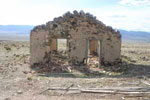 Located 30 miles west of Milford Utah is the old ghost town of Newhouse. Although this area was inhabited as early as 1870 the town never amounted to much until 1900 when Samuel Newhouse purchased the Cactus Mine. Newhouse had a dream to establish a model city for his miners and their families. The small town consisted of stucco homes, a dancehall, restaurant, and one bar located one mile out of town. In the center of town was a clubhouse.
Located 30 miles west of Milford Utah is the old ghost town of Newhouse. Although this area was inhabited as early as 1870 the town never amounted to much until 1900 when Samuel Newhouse purchased the Cactus Mine. Newhouse had a dream to establish a model city for his miners and their families. The small town consisted of stucco homes, a dancehall, restaurant, and one bar located one mile out of town. In the center of town was a clubhouse.
The Historic Cove Fort
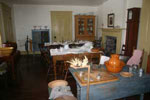 The Cove Fort Historical Site is located 2 miles south of Exit 135 off I-15 and one mile north of Exit 1 off I-70. The fort was built in 1867 at the current site selected by Brigham Young because of the proximity between Fillmore and Beaver. The construction of the fort was over-seen by Ira Hinckley. The fort provided safety, shelter, water and livestock feed for people traveling between the two communities. The fort is square and is constructed of black volcanic rock and limestone that was quarried from the nearby mountains.
The Cove Fort Historical Site is located 2 miles south of Exit 135 off I-15 and one mile north of Exit 1 off I-70. The fort was built in 1867 at the current site selected by Brigham Young because of the proximity between Fillmore and Beaver. The construction of the fort was over-seen by Ira Hinckley. The fort provided safety, shelter, water and livestock feed for people traveling between the two communities. The fort is square and is constructed of black volcanic rock and limestone that was quarried from the nearby mountains.
The Historic Milford Hotel
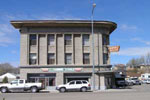 While traveling through Milford Utah to explore the many outdoor activities around the area you couldn't help but notice this grand old building. It appeared it was open as there was a lot of activity around the building. Being very curious we stopped by and our luck paid off as we began to talk with the current owners of the hotel; Bryon Mccarty, Brent and Lynn Severson, and Joy Tomlin.
While traveling through Milford Utah to explore the many outdoor activities around the area you couldn't help but notice this grand old building. It appeared it was open as there was a lot of activity around the building. Being very curious we stopped by and our luck paid off as we began to talk with the current owners of the hotel; Bryon Mccarty, Brent and Lynn Severson, and Joy Tomlin.
Topaz Japanese Relocation Camp
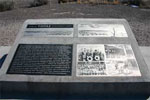 Located west of Delta, Utah is the remains of the Topaz Internment Camp. Between 1942 to 1946 the Topaz camp was home to about 10,000 Japanese who were sent there by the U.S. Government shortly after the attack of Pearl Harbor. War time hysteria caused the relocation of 120,000 Japanese Americans to be relocated to one of ten inland camps.
Located west of Delta, Utah is the remains of the Topaz Internment Camp. Between 1942 to 1946 the Topaz camp was home to about 10,000 Japanese who were sent there by the U.S. Government shortly after the attack of Pearl Harbor. War time hysteria caused the relocation of 120,000 Japanese Americans to be relocated to one of ten inland camps.
The Miller Canyon Mine
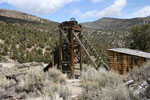 One of the treats you will be rewarded with when exploring Miller Canyon is the old mine. The old shed, mine chute, and cold house are still in great condition considering its age. Inside the shed is an old motorized pulley system still in the same location as it was over hundred years ago. If you look on the chute you can still see the pulleys and how they once hauled up ore from the depths below.
One of the treats you will be rewarded with when exploring Miller Canyon is the old mine. The old shed, mine chute, and cold house are still in great condition considering its age. Inside the shed is an old motorized pulley system still in the same location as it was over hundred years ago. If you look on the chute you can still see the pulleys and how they once hauled up ore from the depths below.
The Old Fort Deseret
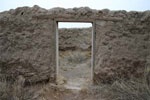 Fort Deseret is located 10 miles southwest of Delta Utah. The fort was erected in 1865 in defense against the Pahvant Indians in the Black Hawk War. The fort was constructed of adobe mud and straw in only 18 days by 98 men. It was 550' square with walls 10' high, 3' wide at the base and 1 1/2' thick at the top, resting on a lava rock foundation.
Fort Deseret is located 10 miles southwest of Delta Utah. The fort was erected in 1865 in defense against the Pahvant Indians in the Black Hawk War. The fort was constructed of adobe mud and straw in only 18 days by 98 men. It was 550' square with walls 10' high, 3' wide at the base and 1 1/2' thick at the top, resting on a lava rock foundation.
The Great Stone Face
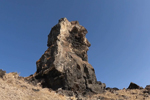 Located just west of Delta is this natural rock formation known as the "Guardian of Deseret". When the Mormon Pioneers traveled hundreds of miles by wagon train and handcarts to settle this western wilderness they discovered this familiar looking rock face. Was this the face of their beloved prophet and leader Joseph Smith, who was killed at the hands of a mob while in the protection of government authorities?
Located just west of Delta is this natural rock formation known as the "Guardian of Deseret". When the Mormon Pioneers traveled hundreds of miles by wagon train and handcarts to settle this western wilderness they discovered this familiar looking rock face. Was this the face of their beloved prophet and leader Joseph Smith, who was killed at the hands of a mob while in the protection of government authorities?
Eastern Utah Prehistoric Museum
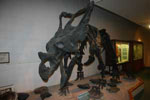 The College of Eastern Utah Prehistoric Museum offers visitors an opportunity to view archaeological and paleontological wonders found nowhere else, including the Utahraptor, the Huntington Mammoth and artifacts from the Fremont Indians. The famous Utahraptor was used by Steven Speilberg in a fictional way for the movie, “Jurrasic Park”. In the movie it was named the “Velociraptor”.
The College of Eastern Utah Prehistoric Museum offers visitors an opportunity to view archaeological and paleontological wonders found nowhere else, including the Utahraptor, the Huntington Mammoth and artifacts from the Fremont Indians. The famous Utahraptor was used by Steven Speilberg in a fictional way for the movie, “Jurrasic Park”. In the movie it was named the “Velociraptor”.
Josie Morris Cabin
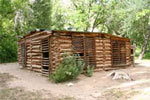 The Josie Morris Cabin is the final destination of the Tilted Rocks Auto Tour. Josie established her homestead here in 1914. She raised and butchered cattle, pigs, chickens and geese. She canned vegetables from her large garden. Her source of heat for her cabin was wood, her water came from a spring, and light from an oil lamp. Josie lived a 19th century lifestyle well into the 20th century. For Josie, the benefits of isolation she experienced living here were solitude and the beauty.
The Josie Morris Cabin is the final destination of the Tilted Rocks Auto Tour. Josie established her homestead here in 1914. She raised and butchered cattle, pigs, chickens and geese. She canned vegetables from her large garden. Her source of heat for her cabin was wood, her water came from a spring, and light from an oil lamp. Josie lived a 19th century lifestyle well into the 20th century. For Josie, the benefits of isolation she experienced living here were solitude and the beauty.